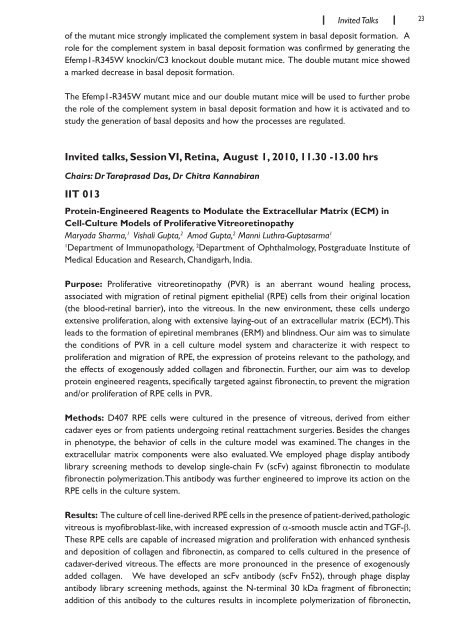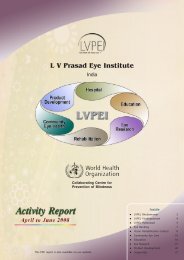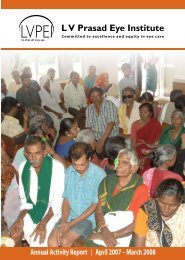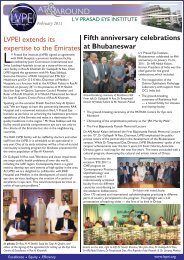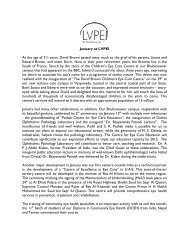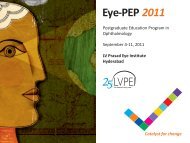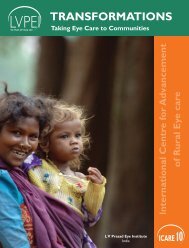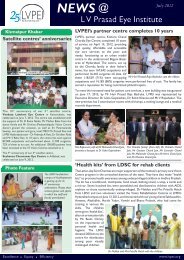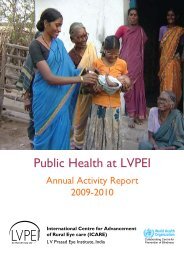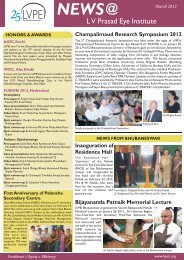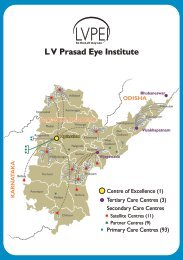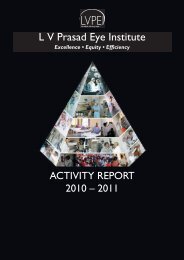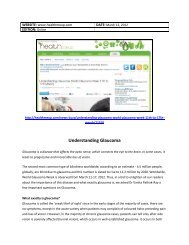IERG Abstracrt Book.indd - LV Prasad Eye Institute
IERG Abstracrt Book.indd - LV Prasad Eye Institute
IERG Abstracrt Book.indd - LV Prasad Eye Institute
You also want an ePaper? Increase the reach of your titles
YUMPU automatically turns print PDFs into web optimized ePapers that Google loves.
Invited Talks23of the mutant mice strongly implicated the complement system in basal deposit formation. Arole for the complement system in basal deposit formation was confirmed by generating theEfemp1-R345W knockin/C3 knockout double mutant mice. The double mutant mice showeda marked decrease in basal deposit formation.The Efemp1-R345W mutant mice and our double mutant mice will be used to further probethe role of the complement system in basal deposit formation and how it is activated and tostudy the generation of basal deposits and how the processes are regulated.Invited talks, Session VI, Retina, August 1, 2010, 11.30 -13.00 hrsChairs: Dr Taraprasad Das, Dr Chitra KannabiranIIT 013Protein-Engineered Reagents to Modulate the Extracellular Matrix (ECM) inCell-Culture Models of Proliferative VitreoretinopathyMaryada Sharma, 1 Vishali Gupta, 2 Amod Gupta, 2 Manni Luthra-Guptasarma 11Department of Immunopathology, 2 Department of Ophthalmology, Postgraduate <strong>Institute</strong> ofMedical Education and Research, Chandigarh, India.Purpose: Proliferative vitreoretinopathy (PVR) is an aberrant wound healing process,associated with migration of retinal pigment epithelial (RPE) cells from their original location(the blood-retinal barrier), into the vitreous. In the new environment, these cells undergoextensive proliferation, along with extensive laying-out of an extracellular matrix (ECM). Thisleads to the formation of epiretinal membranes (ERM) and blindness. Our aim was to simulatethe conditions of PVR in a cell culture model system and characterize it with respect toproliferation and migration of RPE, the expression of proteins relevant to the pathology, andthe effects of exogenously added collagen and fibronectin. Further, our aim was to developprotein engineered reagents, specifically targeted against fibronectin, to prevent the migrationand/or proliferation of RPE cells in PVR.Methods: D407 RPE cells were cultured in the presence of vitreous, derived from eithercadaver eyes or from patients undergoing retinal reattachment surgeries. Besides the changesin phenotype, the behavior of cells in the culture model was examined. The changes in theextracellular matrix components were also evaluated. We employed phage display antibodylibrary screening methods to develop single-chain Fv (scFv) against fibronectin to modulatefibronectin polymerization. This antibody was further engineered to improve its action on theRPE cells in the culture system.Results: The culture of cell line-derived RPE cells in the presence of patient-derived, pathologicvitreous is myofibroblast-like, with increased expression of α-smooth muscle actin and TGF-β.These RPE cells are capable of increased migration and proliferation with enhanced synthesisand deposition of collagen and fibronectin, as compared to cells cultured in the presence ofcadaver-derived vitreous. The effects are more pronounced in the presence of exogenouslyadded collagen. We have developed an scFv antibody (scFv Fn52), through phage displayantibody library screening methods, against the N-terminal 30 kDa fragment of fibronectin;addition of this antibody to the cultures results in incomplete polymerization of fibronectin,


